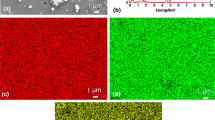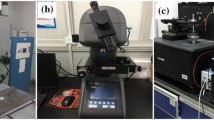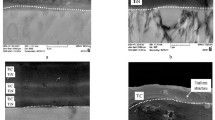Abstract
A TiN/Ti composite coating has been prepared on a Ti-811 titanium alloy substrate by an ion-assisted arc deposition (IAAD) technique. The composition distribution, microhardness, ductility, tribological properties, and fretting fatigue resistance (FFR) at increased temperature of the coating have been investigated. The results indicate that the IAAD technique can be used to prepare a TiN/Ti composite coating with high hardness, good ductility, excellent bonding strength, and high load-bearing capability. The TiN/Ti composite coating can improve the resistance to wear and fretting fatigue (FF) of the Ti alloy at 350 °C because of the good toughness and high bonding strength of the IAAD TiN/Ti composite coating with excellent lubrication of Ti particles in the coating.
Access provided by Autonomous University of Puebla. Download conference paper PDF
Similar content being viewed by others
Keywords
77.1 Introduction
Titanium alloys have been widely used in manufacturing the fans, compressor disks, and blades of advanced aircraft engines [1]. However, titanium alloys are very sensitive to fretting fatigue (FF) damage due to their low thermal conductivities and high coefficients of friction, which may affect the safe reliability of the aircraft engine compressor [2, 3]. Hence, the development of surface modification techniques to improve the fretting fatigue resistance (FFR) of titanium alloys is vital for their safe use in advanced aero-engines with high reliability and long usable life [4–7]. To improve the FFR of titanium alloys at increased temperature, it is necessary to devise other effective surface treatment methods.
TiN coating leads to superior abrasion resistance, a low coefficient of friction, high temperature stability, and high hardness. TiN coating is thus widely used in many industries. Research has indicated that the tribological and fretting wear performances of metals may be improved by a TiN coating [8]. In this paper, the FF behavior of the Ti-811 alloy with TiN/Ti composite coating was studied.
77.2 Experimental Procedures
FF specimens and fretting pads were obtained from Ti-811 titanium alloy bars (∅ 16 mm). Ti-811 alloy is almost all α-phase and contains 7.9 % Al, 1.0 % Mo, 0.99 % V, 0.05 % Fe, 0.1 % C, 0.01 % N, 0.001 % H, 0.06 % O, and balance, Ti. The material was treated by double annealing (910 °C for 1 h, cooled in air, 580 °C for 8 h, cooled in air). The resulting microstructure is an equiaxial α-phase and intergranular β-phase. The mechanical properties of the alloy are as follows: σ b = 931 MPa, σ0.2 = 890 MPa, δ = 23 %, and \( \varPsi = 46\,\% \).
A PIEMAD-03 multifunction apparatus was used to prepare the ion-assisted arc deposition (IAAD) coatings. The IAAD target used in this study consisted of 99.5 % Ti. The specimen was finely ground using 1200 grit SiC paper and ultrasonically cleaned with acetone. Before deposition, the surface of the specimen was cleaned with a 1 keV Ar ion beam in a flux of 20 μA/cm2 for 20 min. To improve the bonding strength between the coating and substrate, a high-energy assisting ion beam was used to bombard the surface of the coating during deposition. The coating deposition processing parameters were arc current: 100 A, bias voltage: −200 V, and N2 pressure: 0.5 Pa.
An HITACHI S-570 scanning electron microscope (SEM) was used to investigate the morphology of the TiN/Ti coating. A GDA750 glow-discharge spectrometer was used to determine the elemental distribution in a cross section of the coating. An XRD-700 X-ray diffraction analyzer was used to analyze the phases of the coating. An HV-1000 microhardness instrument was used to measure the Knoop microhardness of the coating with a load of 0.245 N and loading time of 20 s. The ductility of the coating was estimated using a multi-impact tester with a total number of 1 × 104 impacts. The maximal impact load that resulted in cracking of the coating was defined as the critical ductility load.
The wear resistance of the coating at increased temperature was evaluated using a ball on disk machine with a rotating ball and a fixed disk. The ball was made of Ti-811 titanium alloy. The diameter, the surface roughness R a , and the hardness HK25 of the ball were 4.75 mm, 0.05 μm, and 346, respectively. The disk, made of the Ti-811 titanium alloy, had a diameter of 30 mm, a thickness of 8 mm, and a surface roughness R a of 0.05 μm. The wear tests were conducted under a 5 N load at a temperature of 350 °C, which simulated the conditions of aircraft engine compressors.
A PLG-100C high-frequency fatigue machine was used to conduct FF tests. A schematic drawing of the FF test setup is shown in Fig. 77.1. The load was set in pull–pull mode. The contact state between the pad and the specimen was flat to flat, with a rectangular contact area of 2 mm × 6 mm. Relative slip between the specimen and pad was introduced by the difference in elastic deformation between them. The contact stress of the pads with the specimen was 85 MPa, which was loaded by using a stressing ring. The span length between the fretting bridge foots was 15 mm. The slip was approximately 36 μm for an axial loading force of 500 MPa in sinusoidal form at 110 Hz with a stress ratio of 0.1. The FF life was taken as the average value of three specimens. An electrical resistance furnace was used for heating, and the temperature was controlled at 350 ± 1 °C using a feedback temperature controller with a rectifier and a K-type thermocouple.
77.3 Results and Discussion
Figure 77.2 shows the SEM morphology of the IAAD TiN/Ti coating surface. Many particles with different diameters can be seen on the surface of the IAAD TiN/Ti coating. These particles were formed from the freezing of target drips composed mainly of Ti.
Figure 77.3 shows the XRD pattern of the TiN/Ti coating, with a 2θ scan from 20° to 80°. The TiN/Ti coating shows preferential orientation in the (200), (111), and (220) crystal planes. Among these crystal planes, the (200) plane is the most highly preferential orientation due to the bombardment effect of the assisting ion beam on the coating.
Figure 77.4 shows the elemental distribution over a cross section of the IAAD TiN/Ti coating. The thickness of the TiN/Ti coating is 6 μm. The percentages of Ti and N at the coating surface are 40 and 42 %, respectively. To improve the ductility of the TiN coating and the bond strength between the coating and substrate, a pure Ti interlayer (approximately 3 μm) was deposited between the substrate and the TiN coating. The nitrogen content was seen to increase gradually on going from the Ti coating to the TiN coating, and thus, the hardness of the TiN/Ti coating gradually decreased with increasing depth of the coating and its deformability was improved concomitantly, which was favorable for its tribological and mechanical properties. The mixing interface of the coating element and the substrate element was obtained by the bombardment of the assisting ion beam during the initial deposition stages of the coating, which improved the bond strength between the coating and substrate.
The microhardness test yielded a value of HK25 2,362 for the IAAD TiN/Ti coating, which is a factor of 6.8 higher than that of the Ti-811 alloy substrate. The high hardness of the coating resulted from the ceramic phase of the TiN.
The multi-impact test indicated that the IAAD TiN/Ti coating had very good ductility and high bonding strength. The coating did not crack and delaminate even if the substrate was impacted to collapse under the maximum load of the tester (Fig. 77.5).
Figure 77.6 compares the coefficient of friction of the Ti-811 titanium alloy and the IAAD TiN/Ti coating as a function of friction time at 350 °C. The results indicate that the coefficient of friction of the Ti-811 alloy substrate was 0.55 at the beginning of the experiment and 0.45 at the end. The IAAD TiN/Ti coating reduced the coefficient of friction of the Ti-811 alloy substrate surface from 0.55 to 0.4. The wear resistance of the Ti-811 alloy was improved by the IAAD TiN/Ti coating, which may be attributed to the high density, higher microhardness, and good ductility of the coating.
Figure 77.7 compares the fretting fatigue lives (FFL) of the Ti-811 alloy (labeled BM) and the IAAD TiN/Ti coating (labeled TiN/Ti) at 350 °C. The FFL of the Ti-811 alloy at increased temperature was improved by a factor of 2.4 by the IAAD TiN/Ti coating. The reasons for this may be summarized as follows: The TiN/Ti coating showed good wear resistance, high ductility, and high bond strength. Moreover, the surface contact regime between the TiN/Ti coating and the fretting pads involved the convex peaks contacting the flat surface, which resulted from the softer Ti particles randomly distributed in the hard TiN/Ti coating. The contact area and fretting area were decreased, so the probability of crack initiation was reduced. The softer Ti particles on the harder TiN coating surface provided a good solid lubricating function and absorbed some fretting movement energy. Therefore, the wear resistance of the Ti-811 alloy was significantly improved by the TiN/Ti coating. Simultaneously, the pure Ti interlayer and the mixed Ti and N gradient layer formed a good transition layer between the TiN coating and the Ti-811 alloy substrate. The transition layer not only resulted in the hardness of the whole coating gradually changing along the coating thickness, but also improved the bond strength of the coating. At the same time, cracks initiated in the TiN coating surface were arrested by this transition layer. Hence, the fatigue resistance of the TiN coating was improved. The internal stress of the TiN/Ti coating was relaxed and the ductility of the coating was enhanced due to the soft Ti particles interfusing in the coating.
77.4 Conclusions
In this paper, the effects of the TiN/Ti composite coating prepared by an IAAD technique on the FFR of Ti-811 titanium alloy at increased temperature were investigated. This analysis leads to the following conclusions: A TiN/Ti coating could be prepared on a Ti-811 titanium alloy substrate by IAAD technique. The TiN/Ti coating exhibited high hardness, excellent bonding strength, high load-bearing capability, good ductility, and a low coefficient of friction, and so the wear resistance of the Ti-811 titanium alloy was significantly improved by the coating at 350 °C. The FFL of the Ti-811 alloy with the TiN/Ti coating was improved by a factor of 2.4 as compared to the uncoated substrate at 350 °C because of the excellent wear and fatigue resistance and good ductility of the coating.
References
James CW, Edgar AS (2003) Progress in structural materials for aerospace systems. Acta Mater 51:5775–5799
Ray AK, Das G, Ranganath VR (2004) Failure of connecting pins of a compressor disc in an aero engine. Eng Fail Anal 11:613–617
Bhaumik SK, Rangaraju R, Venkataswamy MA (2002) Fatigue fracture of crank shaft of an aircraft engine. Eng Fail Anal 9:255–263
Hutson AL, Niinomi M, Nicholas T (2002) Effect of various surface conditions on fretting fatigue behavior of Ti–6Al–4V. Int J Fatigue 24:1223–1234
Wei R, Shankar M, Jeffrey H (2004) Evaluation of coatings on Ti–6Al–4V substrate under fretting fatigue. Surf Coat Technol 192:177–188
Hyukjae L, Shankar M, Shamachary S (2005) Investigation into effects of re-shot-peening on fretting fatigue behavior of Ti–6Al–4V. Mater Sci Eng A 390:227–232
Liu DX, He JW (2005) Comparative study on the fretting fatigue and fretting wear behaviors of titanium alloy subject to various surface modifications. Tribology 25:13–17
Sung JH, Kim TH, Kim SS (2001) Fretting damage of TiN coated Zircaloy-4 tube. Wear 250:658–664
Acknowledgments
This work was supported by the National Natural Science Foundation of China (No. 51101127) and Soar Star of Northwestern Polytechnical University (2011) and Fundamental Research Foundation of Northwestern Polytechnical University (JC201213).
Author information
Authors and Affiliations
Corresponding author
Editor information
Editors and Affiliations
Rights and permissions
Copyright information
© 2014 Springer-Verlag Berlin Heidelberg
About this paper
Cite this paper
Zhang, X., Pan, F., Xiang, D. (2014). Characterization of Fretting Fatigue Behavior of TiN/Ti Coating on Ti-811 Alloy at Increased Temperature. In: Wang, J. (eds) Proceedings of the First Symposium on Aviation Maintenance and Management-Volume II. Lecture Notes in Electrical Engineering, vol 297. Springer, Berlin, Heidelberg. https://doi.org/10.1007/978-3-642-54233-6_77
Download citation
DOI: https://doi.org/10.1007/978-3-642-54233-6_77
Published:
Publisher Name: Springer, Berlin, Heidelberg
Print ISBN: 978-3-642-54232-9
Online ISBN: 978-3-642-54233-6
eBook Packages: EngineeringEngineering (R0)











